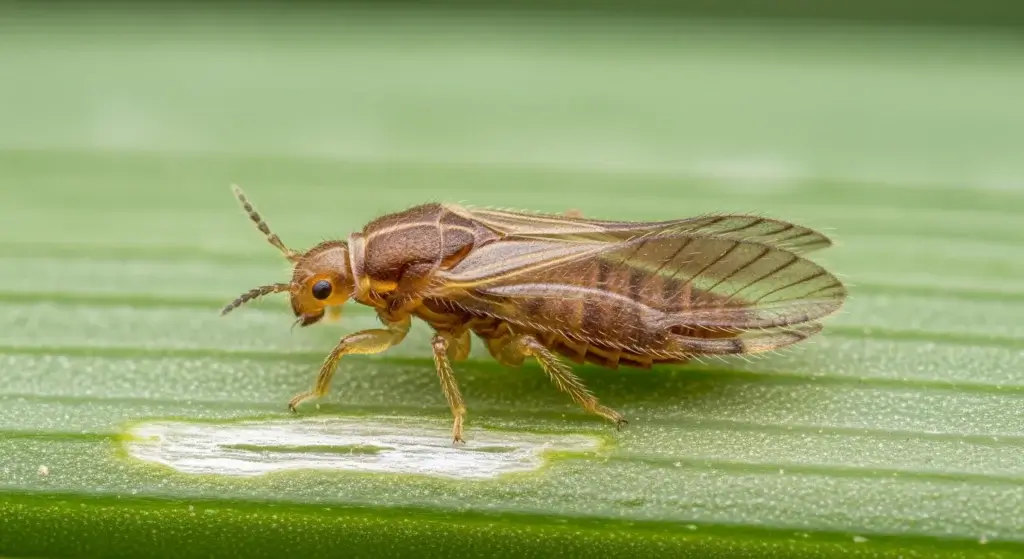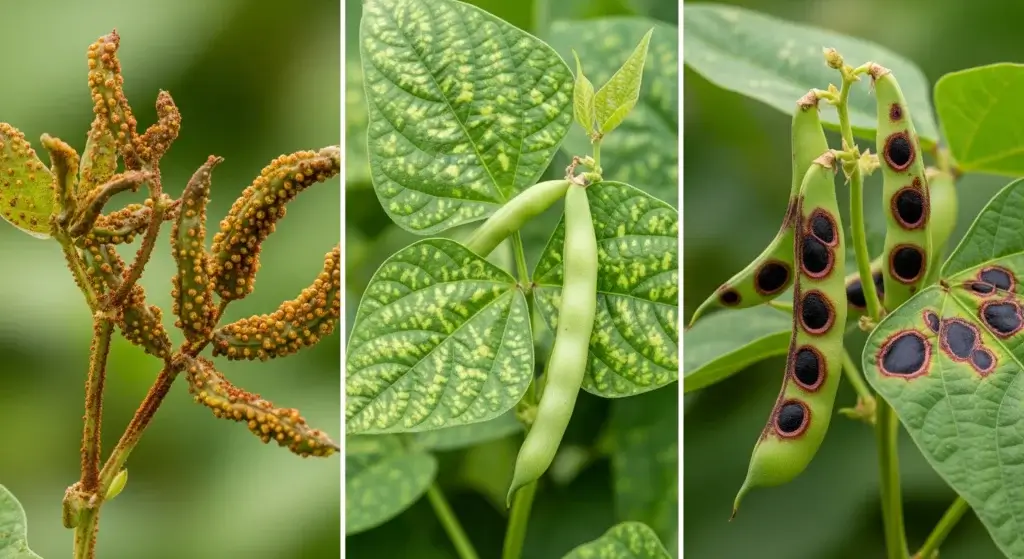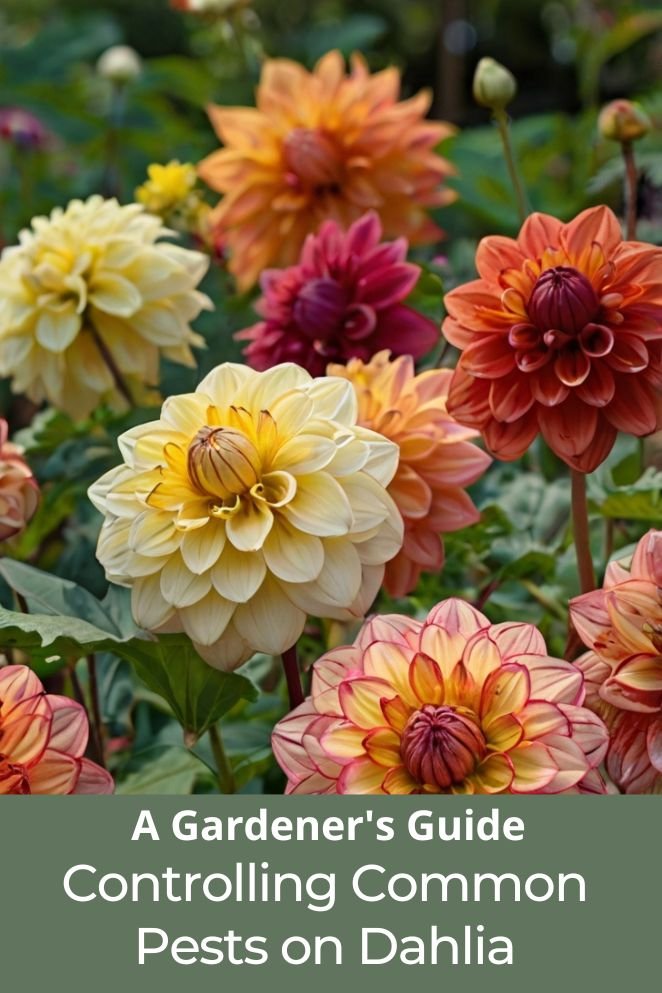
Dahlias are popular for cut flowers due to their long vase life.
These are a gardener’s delight, offering a wide range of colors, shapes, and sizes.
Unfortunately, these beautiful flowers can also attract various pests that can compromise their health and appearance.
From tiny insects that feed on the leaves to larger pests that attack the stems and roots, keeping an eye on your dahlias is essential.
By identifying these pests early and taking preventive measures, you can ensure that your dahlias remain healthy and continue to flourish.
Common Pests on Dahlias
Dahlias, with their vibrant and eye-catching blooms, are a favorite among gardeners.
However, they can also attract a variety of pests that can harm their growth and beauty.
Below is an in-depth look at some of the most common pests that you may encounter on your dahlias.
Aphids
Aphids are tiny, soft-bodied insects, often green but sometimes black, brown, red, or white. They usually gather in clusters on the undersides of leaves and stems.
Damage they cause
These pests feed by sucking sap from the plant, which robs the dahlia of essential nutrients.
As a result, the leaves may curl, turn yellow, and wilt.
Over time, the plant can become stunted and less vigorous.
Aphids also produce a sticky substance called honeydew, which can attract sooty mold—a fungus that forms a black, sooty layer on the leaves.
Furthermore, aphids are known to spread plant viruses, causing even more damage.
How to spot them
To spot an aphid infestation, check for clusters of small insects on the underside of leaves or along the stems. You may also notice sticky honeydew or see ants, which are attracted to it.
Treatment
To manage aphids, you can use a strong spray of water, apply insecticidal soap or neem oil, introduce beneficial insects like ladybugs and lacewings, or, if needed, resort to commercial insecticides.
Spider mites
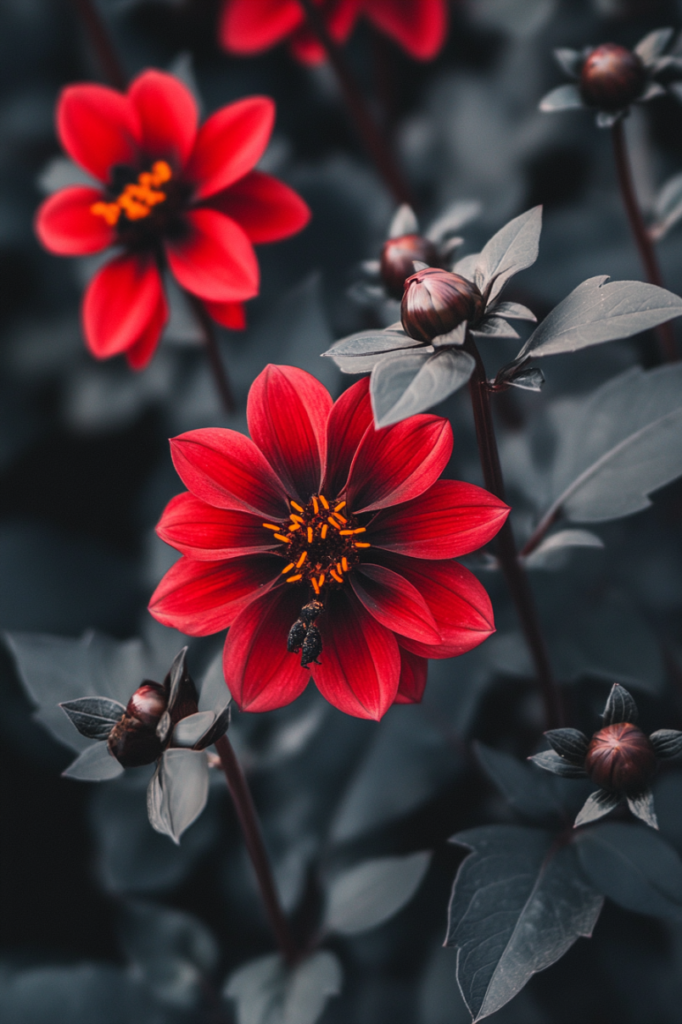
Spider mites are tiny, spider-like pests, usually less than 1/20th of an inch long, making them hard to see without close inspection.
They are often red or yellow and can cause significant damage to plants.
Damage they cause
These mites feed by piercing leaf tissue and sucking out the sap, which leads to a speckled or stippled appearance on the leaves.
As the infestation worsens, the leaves may turn yellow or bronze, eventually drying out and falling off prematurely.
This can severely weaken the plant.
How to spot them
The first signs of a spider mite problem are usually small, discolored spots on the leaves.
You might also notice fine webbing on the undersides of the leaves or between the stems.
To check for spider mites, try shaking an affected leaf over a white piece of paper; you may see the tiny mites falling off.
Treatment
Managing spider mites can involve using insecticidal soap, horticultural oil, or a strong spray of water.
Introducing predatory mites can also help, and increasing humidity around the plants can deter spider mites from thriving.
Thrips
Thrips are tiny, slender insects, only about 1/25th of an inch long, with fringed wings.
They come in various colors like yellow, brown, or black.
Damage they cause
Thrips feed by scraping the surface of leaves, stems, and petals to suck out the plant’s juices.
This feeding leaves behind silver or bronze streaks, spots, or patches on the foliage and petals, giving the plant an unsightly appearance.
Thrips can also cause leaves to curl and become distorted, and in severe infestations, they can reduce the plant’s ability to produce flowers.
How to spot them
Because of their small size, thrips can be hard to spot, but you can identify them by the telltale silvery streaks or the tiny black specks (which are their excrement) on the leaves.
They’re often found on the undersides of leaves or within the flower petals.
Treatment
To manage thrips, you can use insecticidal soap, neem oil, or commercial insecticides.
Encouraging beneficial insects like predatory mites can also help keep their population in check.
Slugs and snails
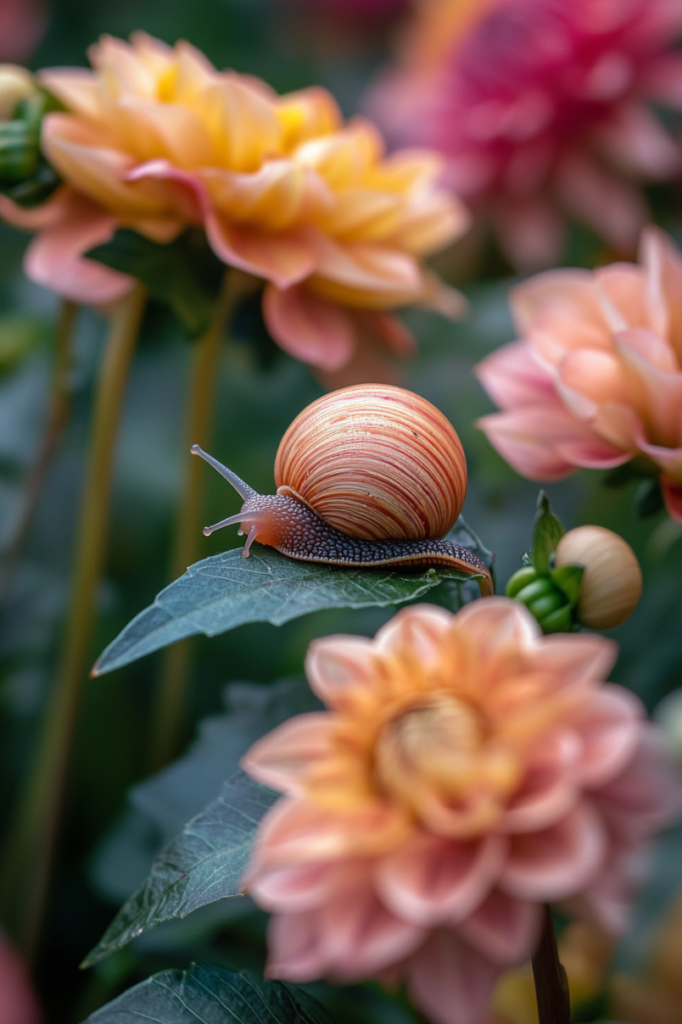
Slugs and snails are soft-bodied mollusks that move slowly and leave behind telltale slime trails. Slugs lack shells, while snails carry a spiral shell on their back.
Damage they cause
These pests are known for feeding on the foliage, stems, and even the flowers of dahlias, creating large, ragged holes.
They are most active at night, especially in damp conditions, so the damage they cause is often most noticeable in the morning after their nighttime activity.
How to spot them
You can easily spot the presence of slugs and snails by the irregular holes they leave in the leaves and the silvery slime trails they deposit.
During the day, you might find them hiding in cool, damp areas.
Treatment
To manage these pests, consider using diatomaceous earth, beer traps, handpicking, or physical barriers like copper tape or crushed eggshells.
Commercial slug baits are also an option for more severe infestations.
Earwigs
Earwigs are nocturnal insects recognized by the pincers on their abdomen.
Typically, brown or black and about half an inch long.
Damage they cause
These insects feed on dahlia leaves, flowers, and petals, leaving behind unsightly holes and ragged edges.
Earwigs are tricky to deal with because they do their feeding at night and hide during the day, making them hard to catch in action.
How to spot them
To spot an earwig problem, look for irregular holes in the leaves and petals, especially those that appear overnight.
During the day, you might find earwigs hiding under mulch, in flowerpots, or in other dark, moist spots near your dahlias.
Treatment
Managing earwigs can involve using traps like flowerpots filled with damp newspaper, handpicking, or applying commercial earwig control products.
Caterpillars

Caterpillars, the larval stage of moths and butterflies, are common pests on dahlias.
The cabbage looper and cutworm are two types often found on these plants.
Caterpillars can vary in color and size depending on the species, but they all share a destructive habit.
Damage they cause
Chewing large holes in the leaves and sometimes the petals of dahlias.
Cutworms are particularly harmful because they can sever young plants at the base, causing them to topple over.
A large caterpillar infestation can result in significant damage.
How to spot them
You can usually spot caterpillar damage by the large, irregular holes in the leaves or missing sections of foliage.
Sometimes, you might see the caterpillars themselves or notice their droppings (known as frass) on the leaves.
Treatment
Managing caterpillars can involve hand picking them off the plants, using Bacillus thuringiensis (Bt) for specific species, or, if necessary, resorting to commercial insecticides.
Leafhoppers
Leafhoppers are small, wedge-shaped insects that can be green, brown, or yellow.
They’re known for their quick movements, either jumping or flying away when disturbed.
Damage they cause
These pests feed on plant sap, causing the leaves to become stippled and turn yellow or brown.
More importantly, leafhoppers can spread diseases like aster yellows, which leads to distorted growth and yellowing leaves, ultimately harming the dahlia’s overall health and vigor.
How to spot them
To identify leafhoppers, look for yellowing or stippled leaves and inspect your plants closely for these small, agile insects.
They often hide on the undersides of leaves.
Treatment
To manage leafhoppers, you can use insecticidal soap, neem oil, or horticultural oil.
Introducing beneficial insects like ladybugs can also help control them.
To prevent leafhopper problems, keep your dahlias healthy, maintain cleanliness, and rotate your planting locations regularly.
Tarnished plant bugs
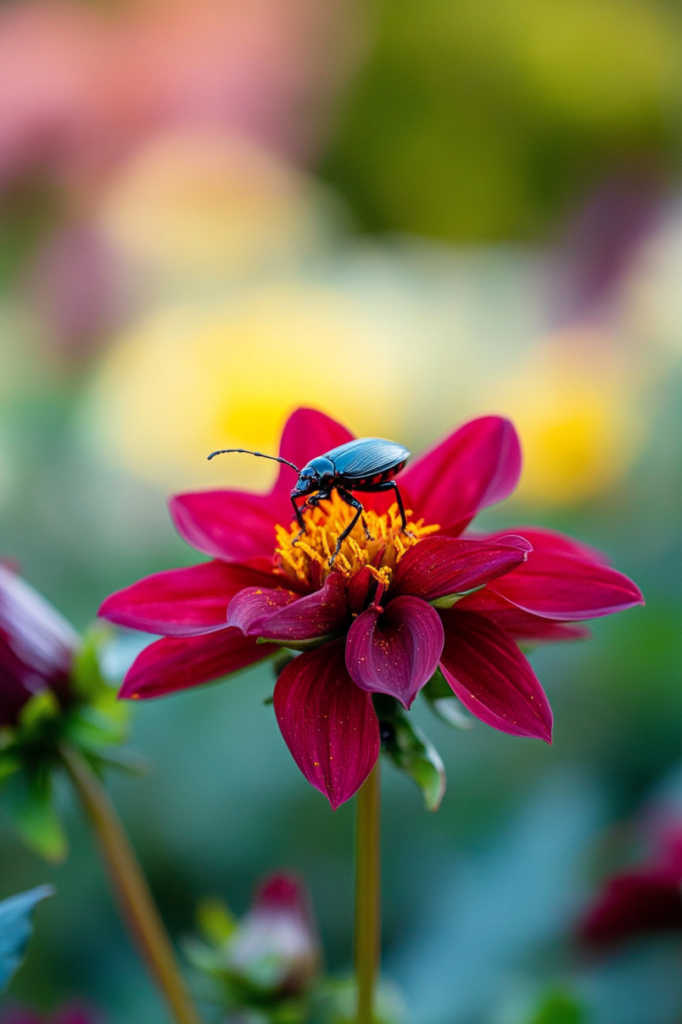
Tarnished plant bugs are small, shield-shaped insects from the Miridae family, usually around 1/4 inch long.
They can range in color from greenish brown to reddish-brown, often with a tarnished or metallic sheen.
Their distinctive triangular shape and piercing-sucking mouthparts make them easily recognizable.
Damage they cause
These pests can create significant problems for dahlias by distorting and curling the leaves, damaging flower buds, and causing malformed blooms.
Prolonged feeding can lead to wilting and overall poor plant health.
If you notice brown or black spots and distorted growth on your dahlias, tarnished plant bugs might be to blame.
How to spot them
To spot these bugs, look for small, shield-shaped insects on your dahlias.
Their feeding often results in damaged or deformed leaves and buds.
Wilting or poor plant growth can also indicate their presence.
Treatment
To manage tarnished plant bugs on your dahlias, start by monitoring your plants regularly for early signs of infestation.
Implement cultural control by removing plant debris and frequently checking for bugs.
For minor infestations, handpicking the bugs can be effective. Use insecticidal soap to suffocate the pests on affected areas.
For more severe problems, apply pyrethrin-based insecticides or neem oil.
Additionally, introduce natural predators such as lacewings or ladybugs to help control the bug population naturally.
Conclusion
Dahlias are a stunning addition to any garden, but they can be vulnerable to a variety of pests.
By understanding the common pests that target dahlias and taking proactive steps to prevent and control infestations, you can enjoy healthy, vibrant blooms all season long.
Regular inspections, proper gardening practices, and the use of natural pest control methods will help keep your dahlias safe and thriving.
Remember, a healthy plant is less likely to be affected by pests, so prioritize the overall health of your garden.
FAQs
Prevent pests by regularly inspecting your plants, spacing them properly, watering at the base, applying mulch, attracting beneficial insects, removing debris, and rotating crops. These practices create a less hospitable environment for pests.
Natural pest control methods include neem oil spray, garlic and chili spray, soap and water solution, beer traps for slugs and snails, and diatomaceous earth. These DIY solutions are effective and environmentally friendly.
While chemical pesticides can be effective, they may also harm beneficial insects and the environment. It’s best to try natural methods first and use chemicals only as a last resort.
Yellowing leaves can be a sign of pest infestation, overwatering, or nutrient deficiencies. Inspect the plant closely to determine the cause and take appropriate action.

